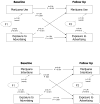Gateway to curiosity: Medical marijuana ads and intention and use during middle school
- PMID: 26030167
- PMCID: PMC4587352
- DOI: 10.1037/adb0000094
Gateway to curiosity: Medical marijuana ads and intention and use during middle school
Abstract
Over the past several years, medical marijuana has received increased attention in the media, and marijuana use has increased across the United States. Studies suggest that as marijuana has become more accessible and adults have become more tolerant regarding marijuana use, adolescents perceive marijuana as more beneficial and are more likely to use if they are living in an environment that is more tolerant of marijuana use. One factor that may influence adolescents' perceptions about marijuana and marijuana use is their exposure to advertising of this product. We surveyed sixth- to eighth-grade youth in 2010 and 2011 in 16 middle schools in Southern California (n = 8,214; 50% male; 52% Hispanic; mean age = 13 years) and assessed exposure to advertising for medical marijuana, marijuana intentions, and marijuana use. Cross-lagged regressions showed a reciprocal association of advertising exposure with marijuana use and intentions during middle school. Greater initial medical marijuana advertising exposure was significantly associated with a higher probability of marijuana use and stronger intentions to use 1 year later, and initial marijuana use and stronger intentions to use were associated with greater medical marijuana advertising exposure 1 year later. Prevention programs need to better explain medical marijuana to youth, providing information on the context for proper medical use of this drug and the potential harms from use during this developmental period. Furthermore, as this is a new frontier, it is important to consider regulating medical marijuana advertisements, as is currently done for alcohol and tobacco products.
(c) 2015 APA, all rights reserved).
Figures

References
-
- Anderson P, De Bruijn A, Angus K, Gordon R, Hastings G. Impact of alcohol advertising and media exposure on adolescent alcohol use: A systematic review of longitudinal studies. Alcohol and Alcoholism. 2009;44(3):229–243. - PubMed
-
- Asparouhov T, Muthén B. MplusTechnical Appendix. 2010. Weighted least squares estimation with missing data.
-
- Britt H, Toomey TL, Dunsmuir W, Wagenaar AC. Propensity for and correlates of alcohol sales to underage youth. Journal of Alcohol and Drug Education. 2006;50:25–42.
Publication types
MeSH terms
Substances
Grants and funding
LinkOut - more resources
Full Text Sources
Other Literature Sources
Medical
Miscellaneous

